
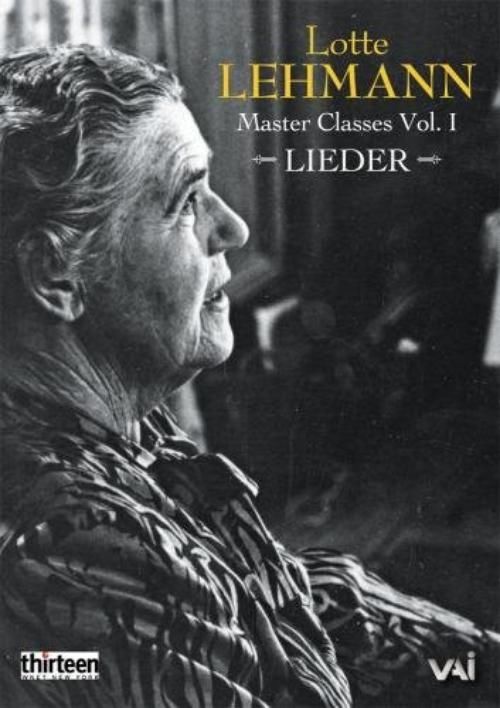
There are two Lehmann masterclass DVDs available from VAI that were filmed at the Music Academy of the West. Lehmann demonstrates both opera and Lieder.
Bumbry Meets Lehmann: In a recent (2021) interview video, Grace Bumbry tells of meeting and studying with Lotte Lehmann.
You can hear what many of Lehmann’s students have to say about their time with her on the Tributes page.
We have adapted the 9-volume Lotte Lehmann & Her Legacy iBooks series to a web format for this site; three of the iBooks deal with Lehmann’s master classes: Volume 3 offers individual songs; Volume 4 provides songs from cycles; and Volume 5 includes both single opera arias and opera scenes. All the original nine volumes are still available free for download from Apple.
At the bottom of this page you can read Beaumont Glass’ opinions about Lehmann’s teaching. He wrote this in response to an article that Martin Bernheimer wrote about Lehmann.
Her most famous students include Marilyn Horne, Grace Bumbry, Benita Valente, and Carol Neblett. She also gave private coaching to already established artists such as Rose Bampton, Eleanor Steber, Nan Merriman, Dorothy Maynor, Hilde Güden, Rita Streich, Mildred Miller, Gérard Souzay, and Risë Stevens. In addition to the famous Lehmann students mentioned above, there are many others who have enjoyed national and international careers. They include, but are not limited to: Lois Alba, Jeannine Altmeyer, Karan Armstrong, Judith Beckman(n), Lincoln Clark, William Cochran, Janice Gibson, Kay Griffel, Leslie Guinn, Raimund Herincx, Jeanette MacDonald, Lotfi Mansouri, Kay McCracken (Duke) (Ingalls), Norman Mittelmann, Thomas Moser, Maralin Niska, Katsuumi Niwa, Evangelne Noël (Glass), William Olvis, Harve(y) Presnell, Marcella Reale, Alberto Remedios, Luba Tcheresky, and Joan Winden. Some of these students have passed on; their obits may be found below.
Click here, if you’re interested in Lehmann’s paintings/speaking/singing/teaching of Winterreise, Die schöne Müllerin, or Dichterliebe.
Lehmann Students (complete [?] list)
Interview with LL Student Katsuumi Niwa
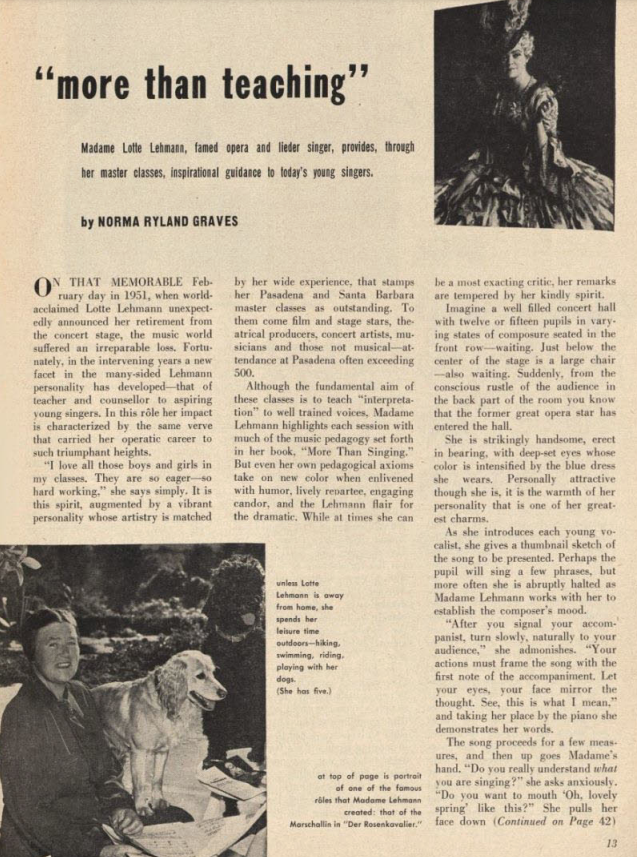
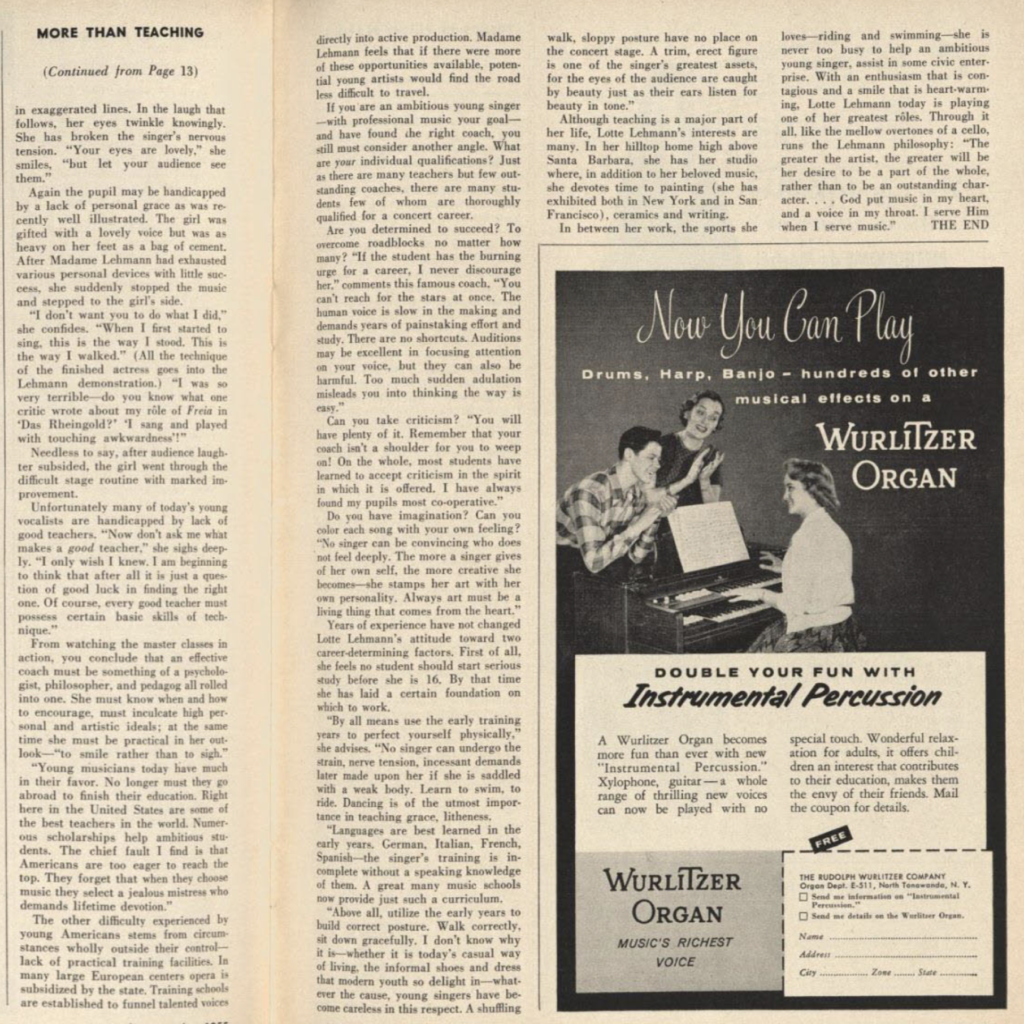
What she said to her students
In the March/April 2022 issue of Fanfare magazine: “…Roderick Williams is a polished singer with a pleasant voice. However, it is overly sweet, overly sentimental, overly ‘sensitive.’ One feels he is trying to convince the listener of his sincerity. ‘I don’t believe you!’ Lotte Lehmann used to say to her students.”
1958 Master Class
Here’s a summary of Lehmann’s master classes at the Music Academy of the West in 1958, sent by Lois Alba.
James Standard sings Ravel’s Chanson épique from the Don Quichotte à Dulcinée set.
Grace Bumbry sings Der Tod das ist die kühle Nacht by Brahms.
Charles Buffam sings Und willst du deine Liebster sterben sehen by Wolf.
Lois Alba sings Brahms’ Feinsliebchen, du sollst mir nicht barfuß geh´n.
An unnamed baritone sings an Italian song.
Kay Griffel sings Ich kann’s nicht fassen, nicht glauben and Du Ring an meinem Finger from Schumann’s Frauenliebe und -leben; LL: talks of not letting down just when you stop…and vowels. Demo
A tenor sings Die Mainacht by Brahms. LL: too explosive… “pipe down a little bit.”
Patricia Jennings sings Debussy’s La chevelure. LL: not sentimental; a spoken demo; “more with eyes.”
Joan Winden sings Botschaft by Brahms.
Lois Alba sings Schubert’s Im Abendrot. LL demos “vater”. After Lois is through LL gives her ideas, but they’re only suggestions. That Lois has her way with the song as well.
Bill Winden sings Verrat by Brahms. LL: “not so legato at the beginning.” Demo
Joan Winden sings Nun will die Sonn’ so hell aufgehn, the first of Mahler’s Kindentotenlieder. LL: “don’t start so loud”; Demo. LL: “life goes on.” “think of eternity.”
James Standard sings Ravel’s Chanson Romanesque from his set Don Quichotte à Dulcinée. LL: “too much reality,” “likable,” “enchanting for crazy exaggerations,” “more emotion,” “from fantasy to emotion.”
Kay McCracken (Duke) sings Mozart’s (really by Spies) Wiegenlied. LL: “a young frivolous mother.” Demo
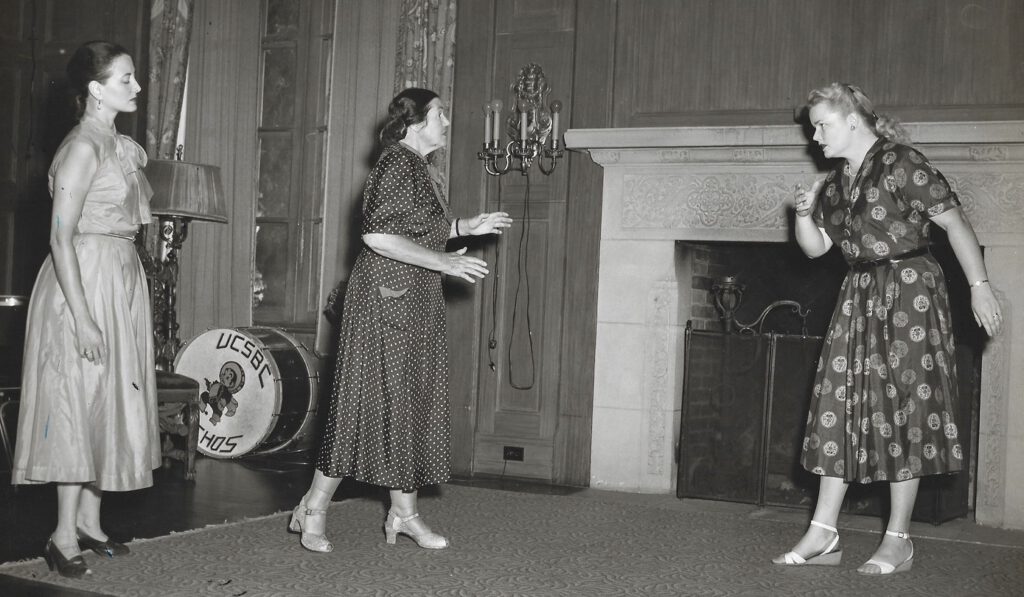
Winterreise in Michigan
Here’s a photo of Lehmann after a Winterreise performance in 1948. Among the young ladies is Bethany Beardsley, who went on to a fine career in song.
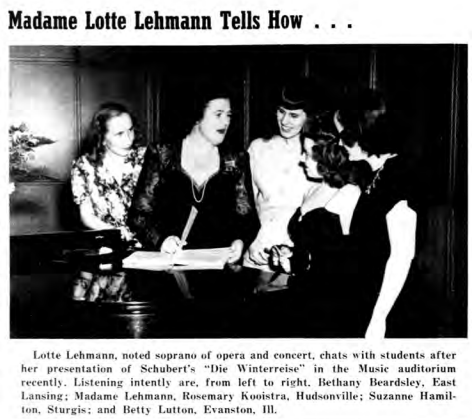
Lehmann Student Kay Griffel Interview
It’s always interesting to read about the career of one of Lehmann’s students who wasn’t as famous as Bumbry or Horne. Griffel’s career was significant (she’s still living) and the interview mentions her work with Lehmann. Read the review.
